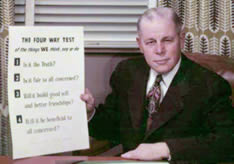
Four-Way Test

In 1932, the creditors of the Club Aluminum Company tasked Herbert J. Taylor with saving the company from bankruptcy. The company was a distributor of cookware and other household items. The company owed its creditors over $400,000 more than its total assets. It was bankrupt but still alive.
While Club Aluminum had a good product, their competitors also had fine cookware with well-advertised brand names. Club also had some fine people working for it, but their competitors also had the same.
Taylor decided Club Aluminum must develop in its organization something that their competitors would not have in equal amount. He decided that it should be the character, dependability and service-mindedness of its personnel.
He believed, "In right there is might." He felt that he needed a simple measuring stick of ethics that everyone in the company could quickly memorize. He also believed that the proposed test should not tell our people what they must do, but ask them questions which would make it possible for them to find out whether their proposed plans, policies, statements or actions were right or wrong.
Here are the four questions he came up with:
- Is it the truth?
- Is it fair to all concerned?
- Will it build good will and better friendships?
- Will it be beneficial to all concerned?
He placed this test under the glass top of his desk and tried it out for a few days. The first day when he checked everything that passed over his desk with the first question, "Is it the truth?," he almost threw the test into the wastepaper basket. He never realized how many untruths appeared in his company's literature.
After he learned to put the test into effect in his dealings, he discussed it with his four department heads. One was Roman Catholic, the second a Christian Scientist, the third an Orthodox Jew and the fourth a Presbyterian.
He asked each man whether or not there was anything in the Four-Way Test that was contrary to the doctrines and ideals of his particular faith. All four agreed that truth, justice, friendliness and helpfulness not only coincided with their religious ideals, but they also should result in greater success and progress. These four men agreed to use the Four-Way Test in checking proposed plans, policies, statements and advertising of the company.
They checked advertising copy against the Four-Way Test, resulting in elimination of statements that could not be proved. Superlatives such as better, best, greatest and finest disappeared from their ads. The public gradually placed more confidence in what they stated in their ads and trusted their products more.
They eliminated all adverse or detrimental comments on their competitors' products from their advertisements and literature. When they found an opportunity to speak well of their competitors, they did so. Thus, they gained the confidence and friendship of their competitors.
The application of the Four-Way Test to relations with their personnel, suppliers and customers helped them win their friendship and goodwill. Soon they realized that friendship and confidence of those they associated with led to success in business.
They were rewarded with a steady increase in sales and profits. From a bankrupt condition in 1932, the company paid its debts in full and paid its stockholders over one million dollars. This resulted from applying the Four-Way Test and having good hard-working employees who had faith in God and high ideals.
They enjoyed a constant increase in the goodwill, friendship and confidence of their customers, their competitors and the public and what is even more valuable, a great improvement in the moral character of their own personnel. They found that if they applied the Four-Way Test to their relations with others at work each day, they got into the habit of doing it at home and in community life.
Rotary added the preamble "Of the things we think, say or do" and adopted the Four-Way Test in January, 1943. Herbert J. Taylor was RI president, 1954-1955.

Next: Lancaster in Rotarian Magazine: Cleft Palate Clinic |